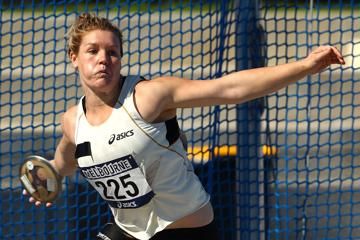Kim Mickle in the women's javelin final at the IAAF World Championships, Moscow 2013 (© Getty Images)
When Kim Mickle recently described herself as “a little girl from Perth who just likes to train and throw things”, she was expressing her feelings at defeating Sally Pearson to win Australia’s Female Athlete of the Year Award last month.
“It’s pretty special,” the Javelin thrower added, after being chosen ahead of an athlete who was the IAAF 2011 Female Athlete of the Year, a World champion the same year and a London 2012 Olympic Games gold medallist.
“She’s the leader of the pack. I’ve tried to hang on to her, follow her pathway. This year, I overtook her for once.”
‘Pretty special’ might convey the feeling of being ranked alongside Pearson, but it also summarises Mickle’s 2013 season, a year which saw her advance from being something of an also-ran to an IAAF World Championships silver medallist. Along the way, she improved her personal best three times.
Where did it come from?
Disappointment in London was a spur. A World Championships finalist the previous year, Mickle crashed out in qualifying at the Olympic Games, and was reduced to watching the stars of her event, rather than seeing herself among them.
The talent was always there. Comparison with Pearson does not sound so fanciful when you consider that Mickle was a gold medallist at the 2001 IAAF World Youth Championships.
Early success then nurtured Mickle’s love of training. The joy of, as she puts it, 'throwing things' was inculcated even earlier, part of an outdoor childhood which largely consisted of following older brother Brett around and playing whatever games he played.
“If he was playing cricket, I was playing cricket. They’d put me on the boundary. I could always throw the ball comfortably to the wicket keeper (in the centre of the field), if not over his head.
“The one thing I was exceptional at, even beating the boys, was throwing a cricket ball. I knew very early on that I had a special arm,” reflected Mickle.
“I jumped into Little Athletics (Australia’s version of Kids’ Athletics) and the javelin because of that and just took it from there.
“Mum (Leanne) had to drag me in at dinner time, then I’d just want to get back out and do whatever my brother was doing: a lot of throwing, but I surfed and played golf, too.
“I still do, I haven’t grown up,” she joked.
Scratches and bruises were an inevitable part of the deal. “I remember going to school one day with so many that a teacher looked at me a bit strange, like Mum was mistreating me or something."
Success as a junior can be twin-edged: sometimes a pointer to further triumphs, as often the pinnacle of a career, but Mickle doesn’t doubt the value of her gold medal in the Hungarian city of Debrecen.
“It was definitely a plus. I went backwards because of injury.”
At the following year’s IAAF World Junior Championships in Jamaica, Mickle snapped the ligament in her throwing elbow. Two reconstructions put her out until 2005.
“Not once did I think of giving up, just of getting back to my sport.
“The success at the World Youths made that happen more easily, because I had a bit of faith in the process.”
It was still stop-go for a few years, but rehab did coincide with an important change. Mickle’s coach, Steve Lemke, moved across the country to Queensland so she teamed up with Grant Ward, who has coached her since.
She competed for Australia on home soil at the 2006 Commonwealth Games in Melbourne and then for Oceania at the IAAF 2006 World Cup, with respectable results, but it took until 2009 for Mickle to reach 60 metres. She had eight consecutive 60-metre-plus competitions through mid-2009, with a best of 63.49m, but was on a down by the time the World Championships in Berlin came around and she failed to make it to the final.
The following year brought a Commonwealth Games silver medal, behind South Africa’s Sunette Viljoen, and a season’s best of 61.36m when taking third place at the IAAF Continental Cup.
Finally, Daegu 2011 saw Mickle reach a major global championship final, where she finished sixth.
“Every year, I tended to hurt myself at the major or before it, so after a major I never had a good pre-season build-up to the next year.”
Even Daegu was tempered by the circumstances: a damaged back in qualifying and cracked rib in the final. For all that, she was a World Championships finalist and her best was now 63.82m.
London beckoned and Mickle went into the qualifying competition with hopes high but crashed out.
She candidly admits she was star-gazing in London. “I had the mind-set that the more I watched, the more I learned. Barbora Spotakova (and) Christina Obergfoll were in the group; the world’s best. I thought watching them was the best way I could get better.”
Nevertheless, every cloud has a silver lining, so they say. At least Mickle came home injury-free and, following an Olympic de-briefing session, she started working with sports psychologist Brian Miller.
The former had obvious physical implications, the latter, more subtle mental ones.
For the first time, Mickle and Ward were able to put together a full build-up for 2013. At the same time, Miller was making progress.
Not ground-breaking stuff, as Mickle sees it, just, “little things".
“I had an ultimate goal, but I never had process goals towards that. Brian taught me never to strive to the ultimate goal but to the process goals. I made little goals I could achieve through my pre-season that led to my ultimate goal.”
Miller also suggested trying to learn and compete at the same time was “over-complicating things”.
“There’s no point watching what other people are doing. I don’t do that now.
“I throw. I assess with the coach: ‘what went right, what went wrong’. Once we’ve agreed, I sit down. I switch off. I might look at other events, but I don’t focus on the Javelin. Four people before my turn, I’ll rehearse my throw in my head, think of my cues, then off I go. I focus my attention on me, no one else.”
No matter how good the strategy, positive reinforcement never hurts, and in 2013, Mickle had it in abundance.
Except for her first domestic competition, she was never under 60 metres. In six competitions in the USA and Europe, she was never outside the top three and improved her personal best to 64.35m at the IAAF Diamond League meeting in Paris.
Mickle went to Moscow brimming with confidence.
“Where you place is beyond your control. I was focused on the Australian record (1996 Olympic Games silver medallist Louise Currey’s 66.80m). I believed I could throw that distance (in Moscow). I actually came in a little under par (66.60m) but a silver medal came with it," added Mickle.
“The 66.60m wasn’t a great throw, there’s room to improve. I want to get that record and build it up and up, to 67, then 68 the year after then Rio 2016, maybe out to 70.”
Mickle also came home from Moscow injury-free and has commenced a second consecutive full pre-season but her intrinsic goals remain unchanged.
“Just to keep improving and see how far I can throw," she concluded. "The ultimate Kim Mickle throw."
Len Johnson for the IAAF






